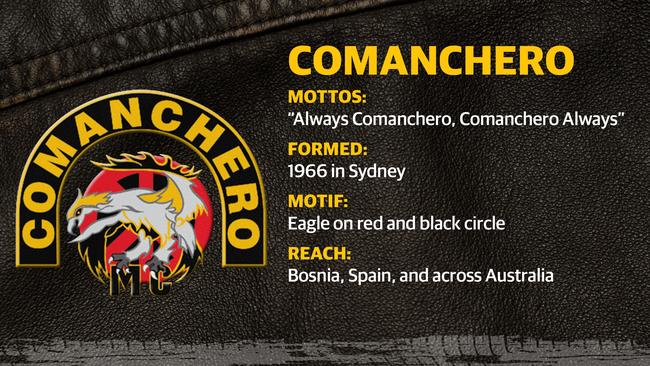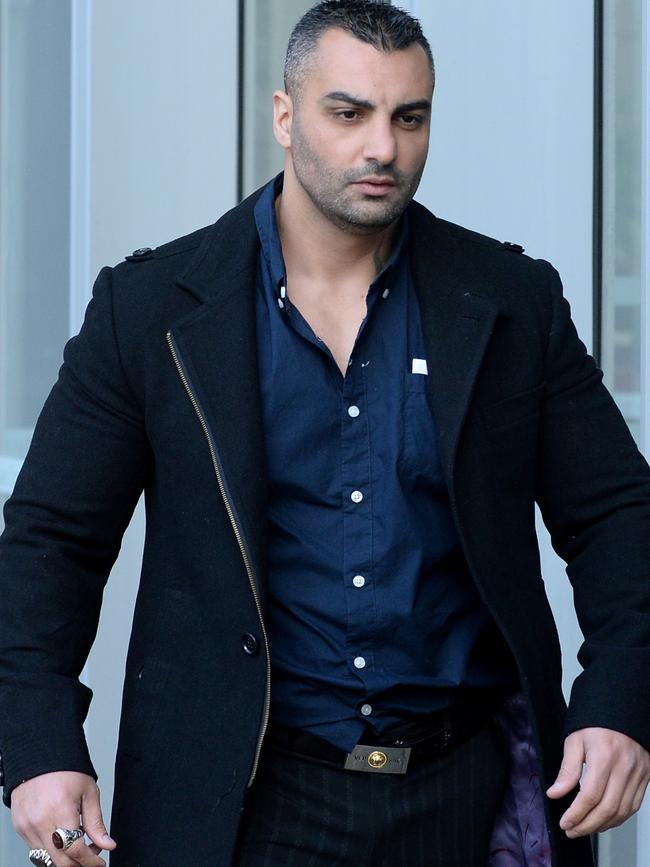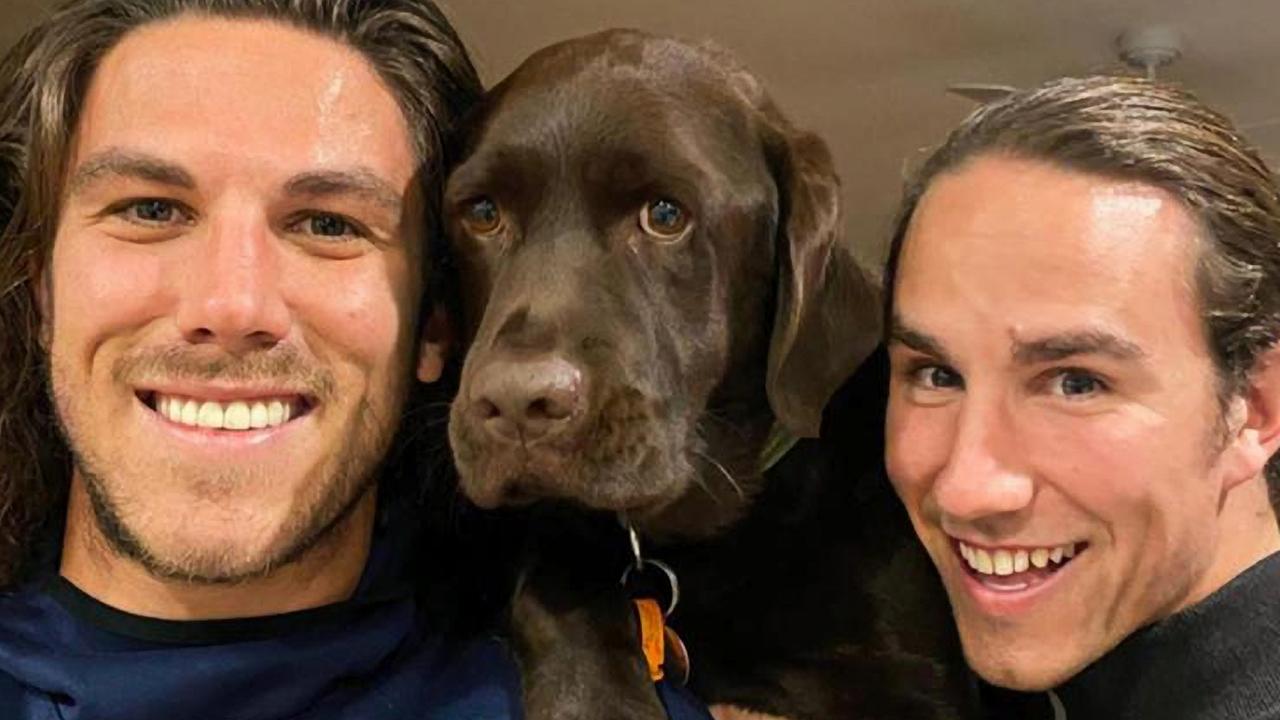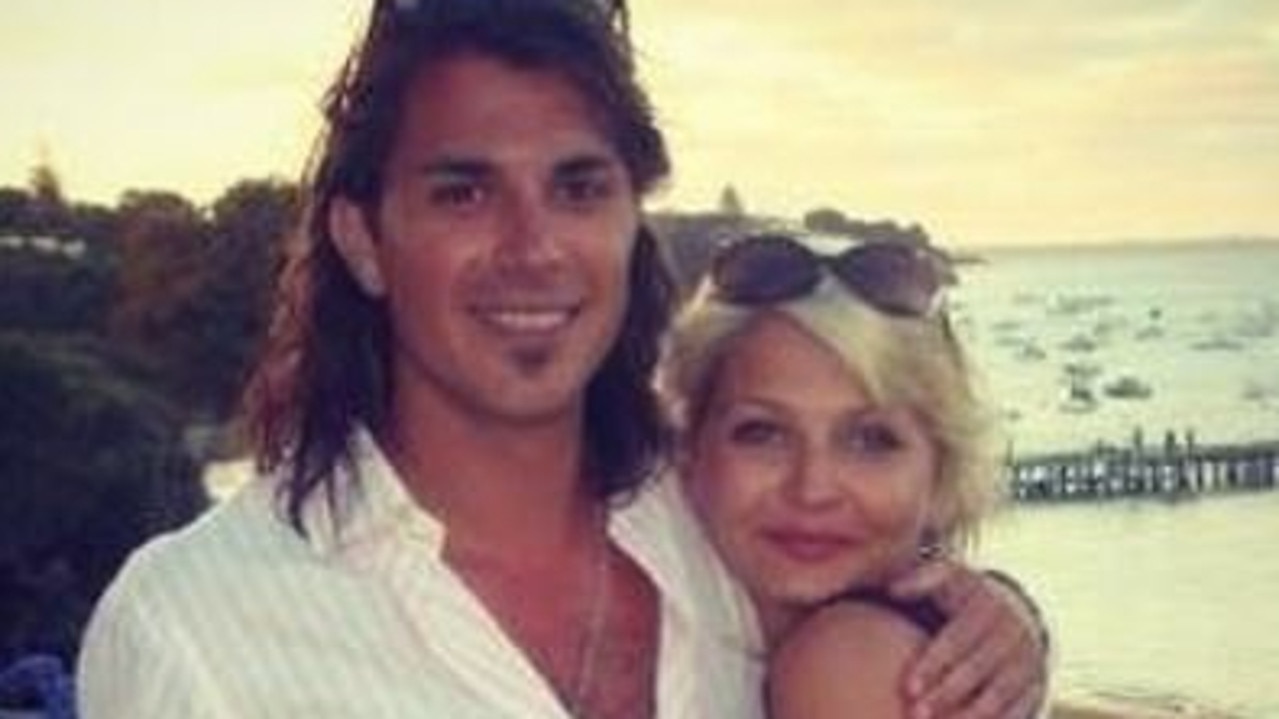How Comanchero became Australia’s most vicious bikies
MORE than just outlaws or gangsters, the Comanchero have climbed the ranks to become the country’s most powerful bikie gang. But it was a violation of their most sacred law that sparked Australia’s most infamous bikie battle — and the tit-for-tat-violence that followed.
Crime in Focus
Don't miss out on the headlines from Crime in Focus. Followed categories will be added to My News.
FOR almost a decade after its inception in 1966, the Comanchero Motorcycle Club kept to itself, shielding the public from boozy, violent behaviour within.
But today they regularly make headlines, from a major sting on several Victorian businesses earlier this year to a shocking all-in bikie brawl at a strip club in Canberra.
Formed in 1966 by Scotsman William George “Jock” Ross. A former soldier, Ross wanted his club to operate like a military unit, a disciplined brotherhood.
THE BRUTAL AND BLOODY HISTORY OF THE BANDIDOS
THE STORY BEHIND THE REBELS BIKIE GANG
WHAT YOU NEED TO KNOW ABOUT THE HELLS ANGELS

Ross dubbed himself “supreme commander” and wrote up a set of ten rules for members to follow, which included such things as not being allowed to have an affair with another member’s partner or wife.
The club has expanded from its Sydney base into Victoria, South Australia and Western Australia, and into Europe.
A long-serving Australian member formed the club’s first international chapter in Sarajevo, Bosnia, in 2004, his home town.
As they created new chapters in recent years the club widened its membership to allow Middle Eastern and Islander members.
Club positions include president, commander, vice-president, sergeant-at-arms and secretary.
Members home nation is shown in a strap below the bird (believed to be an eagle) insignia, with “Comanchero” arched across its top.
Titles are indicated in patches on the front of a vest or jacket.
Other patches include a 1% badge, the state the wearer’s chapter is based in, and ACCA (Always Comanchero, Comanchero Always).
Deceased members of the club are also acknowledged with “In Memory Of” patches on the front of a vest.
Comanchero founder Ross was the club’s only president until he was ousted several years ago.
Prospective members are “nominees” and expected to obey the motto “if the president says jump, ask how high”.

A SHORT HISTORY OF THE COMANCHERO
FOR almost a decade after its inception in 1966, the Comanchero Motorcycle Club kept to itself, shielding the public from boozy, violent behaviour within.
Their founder, Scotsman William George “Jock” Ross, ruled the Sydney-based club with an iron fist, demanding members live by the club’s motto: “Always Comanchero, Comanchero Always.”
They were to abide by club rules such as never to sleep with another member’s “ol’ lady” and, above all, remain loyal to the club.
It was the violation of this latter — and sacred — bikie law that sparked Australia’s most infamous bikie battle in 1984, the Milperra Massacre.
After months of infighting, Ross’ follower Anthony “Snodgrass” Spencer defected from the Comanchero to start the first Australian chapter of the Bandidos, an American bikie gang.
His defection was viewed as treason and on Father’s Day 1984 the two bikie gangs squared off in Milperra’s Viking Tavern car park, as families visiting a motorcycle swap meet ran for their lives.

Four Comanchero, two Bandidos, and innocent Leanne Walters, 14, died during that 10-minute gunbattle, that left at least 20 others injured.
In a landmark criminal trial lasting 14 months, nine men were found guilty of all seven murders and affray, while 21 others were found guilty of manslaughter and affray.
Judge Adrian Roden, who presided over the trial, warned about the dangers of bikie culture.
“As patriotism can lead to jingoism, and mateship can lead to cronyism, so bikie club loyalty can lead to bikie club war,” he said.
On appeal, all nine murder convictions were overturned and all those jailed were back on the streets in just over five years.
Despite leaving prison in a white stretch limousine, Ross claimed the Comanchero “got totally screwed.” He was unrepentant about his role at Milperra.
“I can look at myself in the mirror and know that I was not to blame. I did not cause what happened,” he told News Corp.
“I was blamed for the club splitting because I like things done in a military style; I still do,” Ross said.
HELLS ANGELS: INSIDE WORLD’S BIGGEST BIKIE GANG

TIT-FOR-TAT VIOLENCE
IN THE decade following the massacre, tensions between the Comanchero and the Bandidos simmered away, but both clubs were also careful not to further tarnish their image.
“They still hate each other’s guts but they’re not stupid,” said one gang member said on the Milperra Massacre’s tenth anniversary.
“Besides, they are too busy with other more profitable activities.”
Like most outlaw motorcycle gangs, the Comanchero have been involved in tit-for-tat violence with other gangs over turf and power.
In 1999, the body of Comanchero bikie Peter Michael John Ledger was found dumped in the driveway of his ex-wife’s house.
He had been tortured and beaten to death by Comanchero sergeant-at-arms Ian Clissold for selling a Harley-Davidson motorcycle, against club rules.
According to court papers, Clissold had been ordered to “sort somebody out who had been causing a bit of trouble’’ and that the beating “went a bit too far.”
Both police and the public were becoming concerned by the increasing power of a smaller group of bikie gangs, linked to a pact to limit the number of gangs controlling the drugs market.

“In early 1994, following the world trend, there was a meeting in Sydney between the major gangs where it was decided informally that the gangs in the country would adopt a similar stance to that already being set up by the rest of the OMCG (outlawed motorcycle gangs),” a New Zealand report into organised crime read.
“It was agreed in principle that there would be a maximum of six gangs controlling Australia by the year 2000, hence the project being dubbed The Australia 2000 Pact,” said the report.
It appeared that the Comanchero may have been locked out of the lucrative drug market, as they were not included in the six powerful gangs vying for dominance.
But they survived, and in 2001, their western Sydney headquarters in Erskine Park was firebombed, causing about $40,000 damage.
In the following years, police suspected a feud between the Comanchero and the Nomads was escalating after a spate of clubhouse firebombings, bashings and drive-by shootings.
The Comanchero were also suspected of spraying more than a dozen bullets into Sydney’s DCM nightclub, linked to the Nomads, injuring three people in May 2007.


Later that year, Comanchero boss Mahmoud “Mick” Hawi was the target of a shooting at Grappa Restaurant in Leichhardt, before the warring between the Comanchero and Nomads ceased.
The Comanchero didn’t stay quiet for long, however, as a turf war soon exploded when Hells Angel Peter Zervas opened a tattoo parlour in Brighton-Le-Sands, known as Comanchero territory.
In a move that worried police, a bomb cushioned with sandbags to direct the impact was used to firebomb the Hells Angel’s Petersham clubhouse, with the Comanchero suspected of the attack.
A few days later, a Comanchero was shot in the leg by four men alleged to have been wearing Hells Angels colours.
Just like the Milperra massacre, the tit-for-tat warring between the Comanchero and the Hells Angels boiled over with tragic consequences in Sydney Airport in March 2009.
Hawi and four other Comanchero had boarded a flight from Melbourne to Sydney. Hells Angels chapter president Derek Wainohu also happened to be on board.
When the plane touched down, each gang called for reinforcements.
The ensuing wild brawl in front of horrified travellers claimed the life of Peter Zervas’ brother, 29-year-old Anthony Zervas.

Fourteen people were charged with the murder — 11 Comanchero and two Hells Angels, including Hawi.
Just days after the attack, Hawi banned the wearing of Comanchero club colours and riding of motorcycles in a bid to curb the escalating bikie violence.
But Hawi’s call for calm among bikie gangs was ignored when Peter Zervas was shot as he arrived at his mother’s home nine days after the airport brawl.
Police found Zervas leaning against his white car which was left streaked with his blood.
They are still to nail the shooter.
Amid the escalating and public violence, the NSW government introduced legislation to outlaw the bikie gangs, which led the “one per cent” clubs — bikie gangs who ignore the law — to band together.
They set up a United Motorcycle Council and even hired a PR company to repair their shattered public image.
A court mix-up in 2009 saw Hells Angel David Padovan fax the names and addresses of 47 Comanchero, including those involved in the airport brawl, instead of a list of Angels he was barred from associating with.
An immediate inquiry was called to investigate the bungle.
Despite the carnage of that year, the Comancheros’s Sydney chapter celebrated Christmas in 2009 by cruising the Sydney Harbour.
FEARS FOR JAILED COMANCHERO BOSS

More than two years after the airport brawl, Hawi was found guilty of murdering Anthony Zervas, while the 13 others were found not guilty.
Zervas’ mother Frederica Bromwich called out: “No punishment is enough for the loss of my son,” as Hawi was jailed.
Sentenced to a non-parole period of at least 21 years, Hawi had to give up the presidency of the Comanchero club he had held since the age of 22.
But the murder conviction was overturned after Hawi won his appeal and pleaded guilty to manslaughter and affray.
Hawi was released in May 2015 but came to a bloody end when he was gunned down outside a gym in Rockdale on February 15. His killers are still on the loose.


While the bikie wars raged on, the Comanchero expanded from their Sydney base into South Australia and Victoria.
At the helm of the South Australian expansion was former Hells Angel and founder of New Boys street gang Vince Focarelli.
Just a year later in December 2011, Focarelli was stripped of his club presidency.
He survived three attempts on his life and bragged on Facebook that he was “the only man on the planet with nine lives”.
From hospital after one attempt he released a statement reading, “Mr Focarelli denies there is any disharmony or in-house fighting with the Comanchero Motorcycle Club.”
Three weeks later, he survived a fourth attempt on his life, but his 22-year-old son Giovanni was killed.

The Comanchero have recently expanded their reach in Victoria and boast a lavishly decorated clubhouse in Port Melbourne.
The Spearmint Rhino strip club is a known Comanchero haunt in Melbourne, and the gang runs three clubhouses in suburban Victoria.
In August 2017, dozens of members from the Comanchero Outlaw Motorcycle Gang came to blows inside the Capital Men’s Club in Fyshwick.
Footage of the all-in bikie brawl at the strip club emerged as some of those involved in the Canberra fight faced court in 2018.
The fight spilled from the smoking area into a larger section of the club, where it escalated.
It’s understood about 100 members of the Comanchero OMCG from across the country had converged last August for the gang’s 2017 memorial run and senior Victorian members of the gang were believed to have been present.
RELATED CONTENT:


